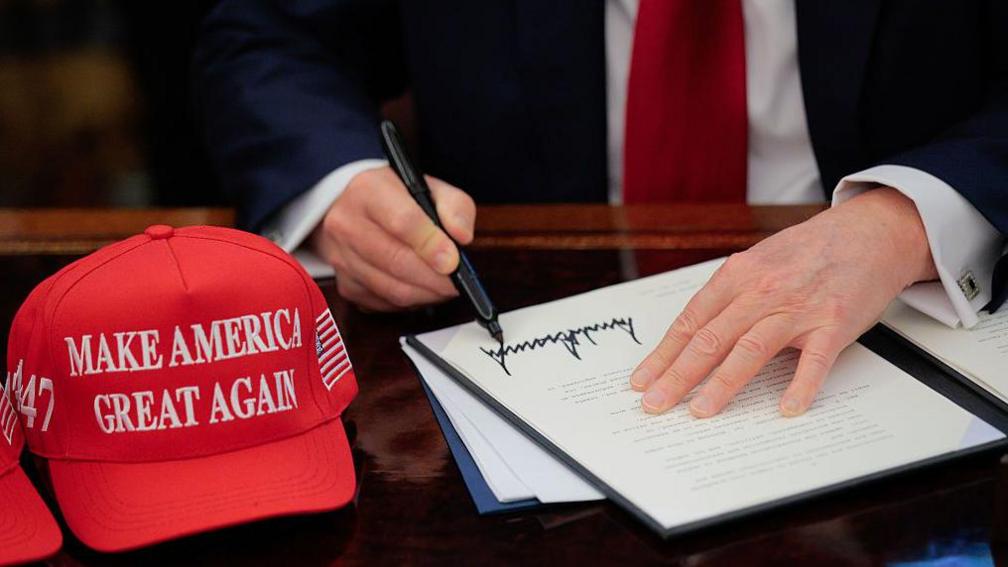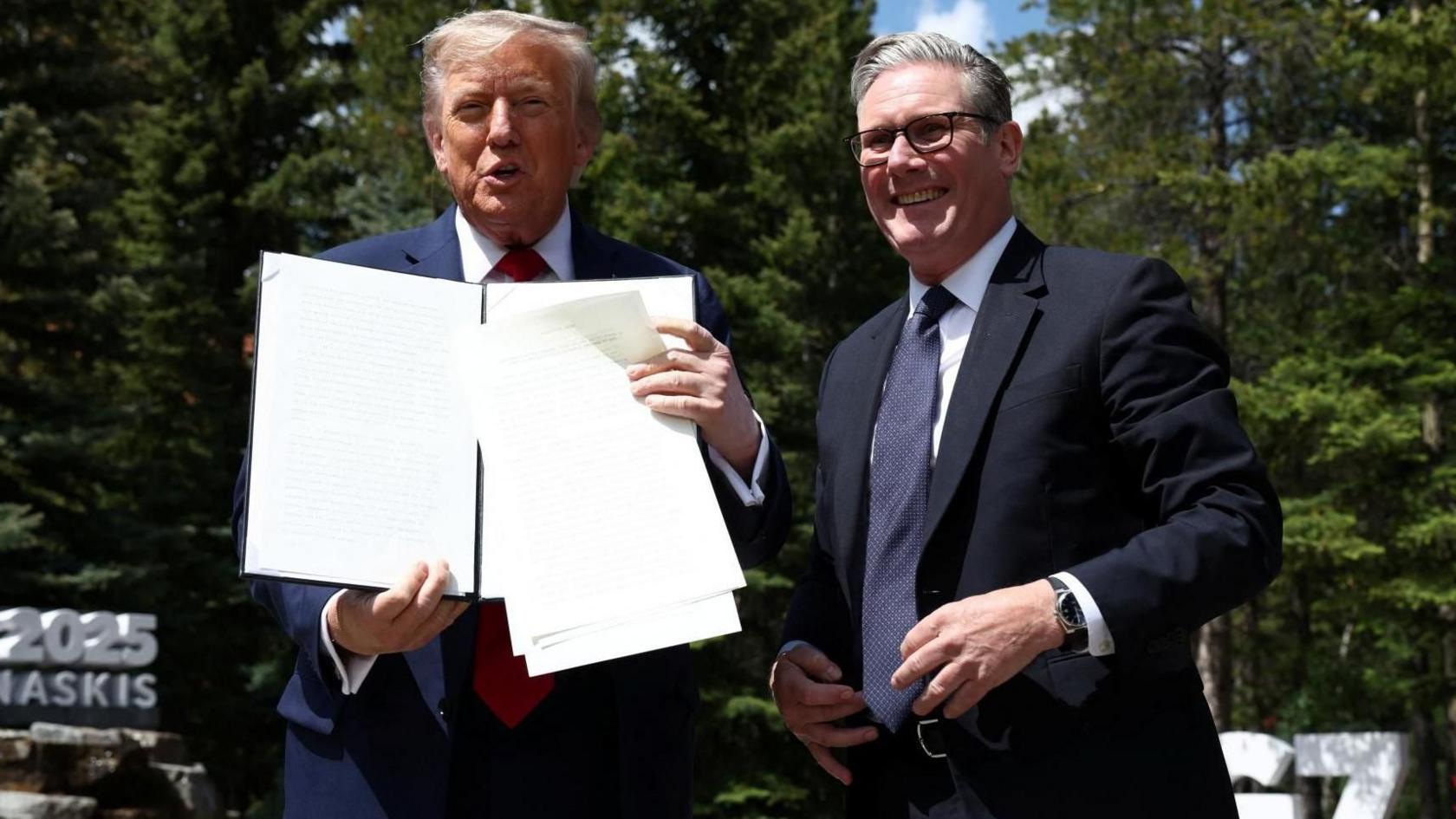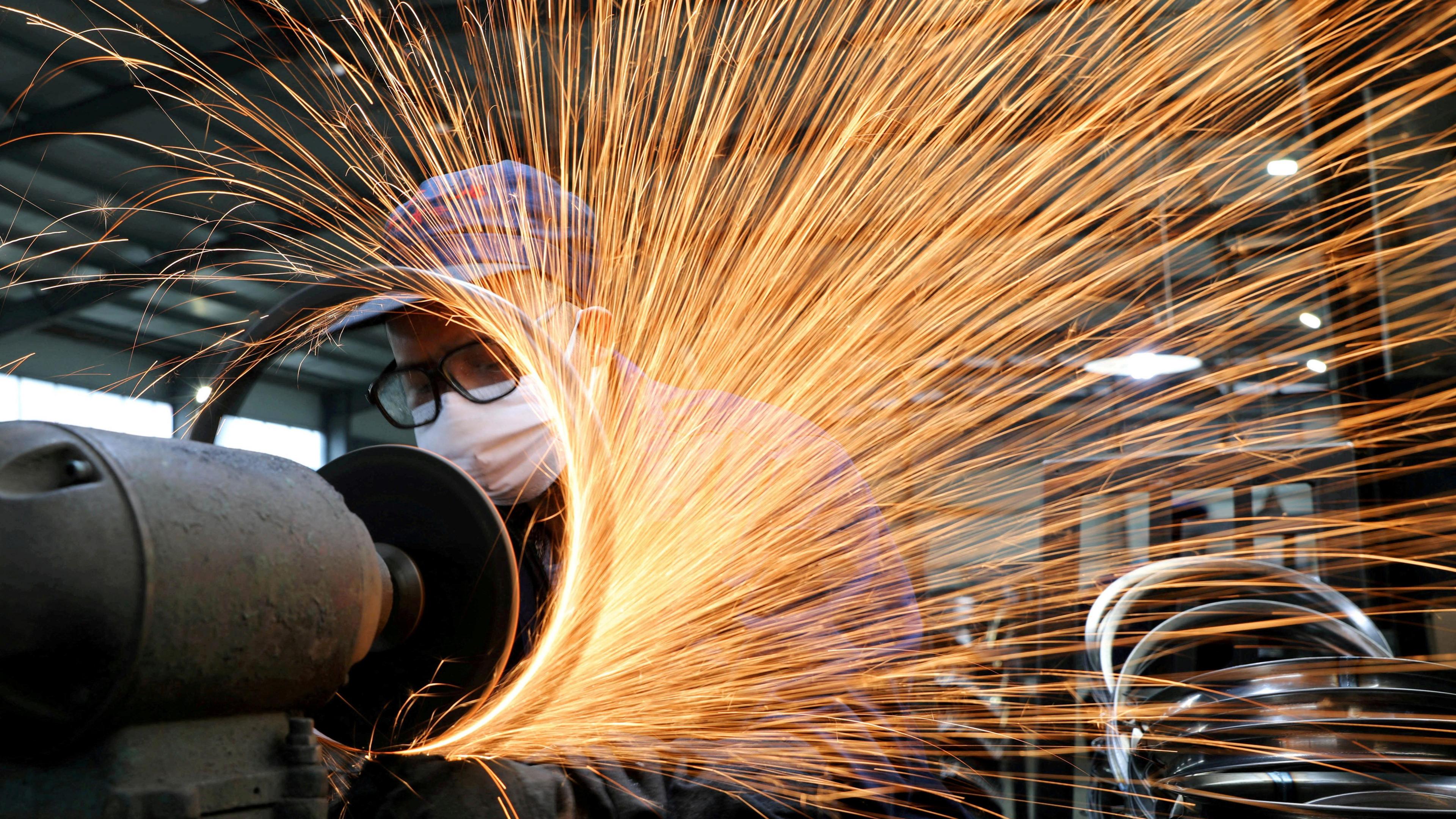What tariffs has Trump announced and why?

- Published
US President Donald Trump has introduced tariffs on goods reaching it from countries around the world.
Trump argues that the move will boost American manufacturing and create jobs, but critics warn of higher prices and damage to the global economy.
The US Supreme Court is also considering whether the tariffs are illegal.
What are tariffs and how do they work?
Tariffs are taxes on imported goods.
Typically, the charge is a percentage of a good's value.
For example, a 10% tariff on a $10 product would mean a $1 tax on top - taking the total cost to $11 (£8.34).
The tax is paid to the government by companies bringing in the foreign products.
These firms may pass some or all of the extra cost on to their customers, which in this case means ordinary Americans and other US businesses.
They may also decide to import fewer goods.
Why is Trump using tariffs?
Trump says tariffs will increase the amount of tax raised by the government, encourage consumers to buy more American-made goods and boost investment in the US.
He wants to reduce the US trade deficit - the gap between the value of goods it buys from other countries and those it sells to them.
The president argues that the US has been exploited by "cheaters" and "pillaged" by foreigners.
Trump has also used the taxes to make other demands.
For example, when announcing tariffs against China, Mexico and Canada, he said the countries must do more to stop migrants and the illegal drug fentanyl reaching the US.
Many tariffs have been amended or delayed after being announced.
Why is the Supreme Court considering the legality of Trump's tariffs?
Trump's tariffs have faced numerous legal challenges because of the way they were introduced.
Instead of getting Congressional approval for the tariffs, the Trump administration used the 1977 International Emergency Economic Powers Act. Declaring an emergency under the law meant Trump could issue immediate orders and bypass the established process.
In August, a US appeals court ruled that most of Trump's tariffs were illegal, but left them in place.
The White House asked the US Supreme Court to overturn that decision, and it began hearing arguments in the case on 5 November.
A final outcome is not expected for several months.
What are Trump's tariffs on individual countries?
Negotiations are continuing with a number of countries, including America's top three trading partners. China, Canada and Mexico were warned they would face particularly high tariffs:
China and the US threatened tariffs on each other's goods of more than 100% in the months after Trump took office, but extended a truce until November. On 30 October, after meeting President Xi Jinping, Trump said the two countries would sign a trade deal "pretty soon". He announced an immediate end to the part of tariffs levied on Chinese goods over concerns about Beijing's failure to stop the flow of ingredients used to make fentanyl. However, it is not clear which other duties will remain, or at what level
Canada is facing 35% tariffs on its goods - although most are exempt under the existing United States-Canada-Mexico (USMCA) free trade agreement. Canada is affected by the blanket 50% levy on imported metals and 25% on non-US automobiles. On 25 October, Trump said he was suspending trade talks and would increase Canada's levies "by 10% over and above what they are paying now", after the country broadcast an anti-tariff advert
Mexico is facing 30% tariffs on its goods, plus the sector-specific levies and a 25% fentanyl tariff. However, like Canada, most of its goods are exempt under the USMCA. The tariffs were put on hold until the end of October to allow time to strike a deal. On 27 October, Mexican President Claudia Sheinbaum said she and Trump had agreed to extend this deadline by "a few more weeks"
Canada and Mexico agree to deepen ties amid Trump trade war
- Published19 September
How are trade deals actually negotiated?
- Published24 July
A patchwork of different rates is in place for other countries.
Many of these stem from Trump's announcement in April that a "baseline" of 10% would apply to imports from all countries. Nations considered the "worst offenders" would face higher rates, as payback for unfair trade policies.
New tariff rates for dozens of countries were subsequently introduced in August, after delays to allow for trade talks.
These include:
50% tariffs on Indian goods - including a 25% penalty for trade with Russia
50% tariffs on Brazilian goods
30% tariffs on South African goods
20% tariffs on Vietnamese goods
15% tariffs on Japanese goods
15% tariffs on South Korean goods
15% tariffs on most EU goods
What is the UK tariff deal?

At 10%, the UK has negotiated the lowest US tariff rate so far of any country that has struck a deal with Trump.
It exported about £58bn of goods to the US in 2024, external - mainly cars, machinery and pharmaceuticals.
The 10% rate applies to the first 100,000 UK vehicles exported every year - roughly the number of cars sold in 2024. Additional vehicles face the standard 25% tariff.
The agreement also lets the two countries sell beef to each other. Some US ethanol will face 0% tariffs, instead of 19%.
Trump announced "the deal was done" in June, but did not confirm the expected removal of all charges on steel imports from the UK.
The UK is the only country which does not face 50% tariffs on steel and aluminium. It pays 25% instead.
The BBC understands the plan to eliminate tariffs on UK steel exports entirely has now been put on hold.
However, speaking to reporters ahead of his second state visit to the UK in September, Trump said said he was "into helping" Britain fine-tune the deal.
Which goods are affected by Trump's tariffs?
Some taxes announced by Trump are on particular products, wherever they are made.
These include:
100% tariff on branded or patented drugs (unless a company is building a factory in the US)
50% tariff on steel and aluminium imports (except for those from the UK)
50% tariff on copper imports
50% tariff on kitchen and bathroom cabinets and some furniture
25% tariff on most foreign-made cars, engines and other car parts
25% tariff on all heavy-duty trucks

The US is the biggest importer of steel in the world after the EU, with most coming from Canada, Brazil, Mexico and South Korea
In addition, Trump ended an exemption for imports valued at $800 (£592) or less.
It means low-cost goods are no longer duty-free - a move affecting millions of packages sent every day, including those from online retailers like Shein and Temu.
The companies shipping the parcels now have to pay duties based on the tariff rate which applies to the country the goods were sent from. Otherwise, for six months, they can choose to pay a fixed fee of between $80 and $200 per package.
Are prices going up for US consumers?
Shoppers have already seen price rises for some products.
US inflation was 3% in the 12 months to September, having gone up since April, when it stood at 2.4%.
The cost of groceries was up 2.7% over the period. Beef and veal were up more than 14%, while coffee surged by nearly 19%.
Prices for furniture, which is also heavily imported, went up by almost 4%. That increase did not reflect the 50% tariffs on some furniture which began in October.
Many firms have warned they will pass on the cost of tariffs to customers, including Target, Walmart and Adidas.
The cost of goods manufactured in the US using imported components is also expected to rise.
For example, car parts typically cross the US, Mexican and Canadian borders multiple times before a vehicle is completely assembled.
Despite the price rises and continuing uncertainty about the impact of tariffs, the latest official figures show that consumer spending increased by 2.5% in the year to the end of June, up from a previous estimate of 1.6%.
However, it is not yet clear whether tariffs have since had an impact.
Poorer Americans hit hardest as tariffs fuel price rises
- Published16 September
US beef prices are soaring. Will Trump's plans lower them?
- Published25 October
The US factory spending $100,000 a month more due to tariffs
- Published8 September
How are tariffs affecting the US and global economies?
Trump was accused of throwing the global economy into turmoil when he announced the first tariffs of his second presidential term.
Although financial markets have since largely recovered, in October the International Monetary Fund (IMF) said the overall picture remained volatile, and that US tariffs were having a negative effect.
It forecast global growth of 3.2% in 2025, and 3.1% in 2026. That was a slight increase from its July predictions, but still below the 3.3% it had projected for both years before Trump's measures were announced.
It thinks the US economy will grow by 2% in 2025, and 2.1% in 2026. That's down from the 2.8% growth recorded in 2024, but still the fastest among the world's most advanced economies.
The most recent US figures show the economy actually grew at an annual rate of 3.8% between April and June 2025, up from an earlier estimate of 3.3%.
US tariff revenues have increased sharply. Official US data showed they were $28bn in June 2025, triple the monthly total in 2024.
The Congressional Budget Office, an independent watchdog, estimated that the tariffs imposed between 6 January and 19 August 2025 would reduce government borrowing in the 10 years to 2035 by $3.3tn.
However, it previously suggested tariffs would also shrink the overall size of the US economy.